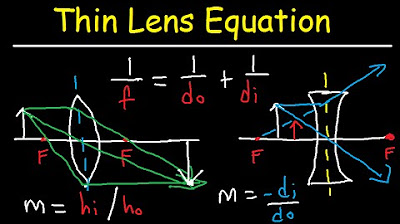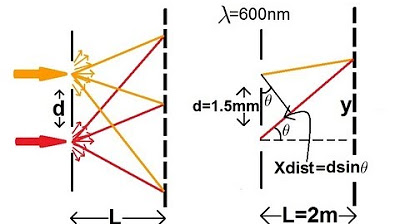AP Physics B Exam Review - Waves and Optics
TLDRThis AP Physics review covers waves and optics, focusing on the similarities and differences between sound and light waves, including their speeds in various mediums. It delves into concepts such as longitudinal and transverse waves, interference, Snell's law, and the behavior of light in different media. The review also explains lens and mirror properties, including converging and diverging lenses, concave and convex mirrors, and their respective images. It concludes with discussions on Young's double-slit experiment and thin film interference, providing essential knowledge for the AP exam.
Takeaways
- 🌊 Sound and light waves are fundamentally the same but travel at different speeds in various mediums.
- 🎚 Longitudinal waves, such as sound waves, move faster in denser mediums due to closer molecular spacing.
- 🔊 The speed of sound is approximately 340 meters per second in air, faster in water, and even faster in solids.
- 🌌 Transverse waves, like light waves, move perpendicular to the surface and have distinct wavelengths and frequencies.
- 🚀 The speed of light is approximately 3 x 10^8 meters per second, which is much faster than the speed of sound.
- 🔄 Both sound and light waves exhibit constructive and destructive interference, which can be calculated using the formula velocity = wavelength × frequency.
- 📏 Standing waves in a tube can be analyzed using the relationship between the change in length and half the wavelength.
- 🔍 Snell's law and the refractive index (n) are crucial for understanding how light bends when it enters a different medium.
- 💡 Reflection and refraction are key concepts in optics, with reflection occurring at the same angle as incidence and refraction bending light at different angles.
- 🔭 Lenses and mirrors have specific properties; converging lenses create real, inverted images, while diverging lenses produce virtual, upright, and smaller images.
- 📐 Young's double-slit experiment demonstrates the wave nature of light through constructive and destructive interference patterns.
- 🎨 Thin film interference, visible in the colors seen on soap bubbles, can be used to determine the thickness of a film using specific equations.
Q & A
What are the two main types of waves discussed in the script?
-The two main types of waves discussed in the script are sound waves and light waves.
How do longitudinal waves travel and what are their characteristics?
-Longitudinal waves, such as sound waves, travel in a horizontal fashion with compressions and rarefactions. They have a wavelength and frequency, and they move faster in more dense mediums.
What is the speed of sound in air and how does it compare to its speed in water?
-The speed of sound in air is approximately 340 meters per second, which is much slower than in water due to the closer proximity of water molecules that allow longitudinal waves to bounce off each other more effectively.
How do transverse waves differ from longitudinal waves in terms of their direction of travel?
-Transverse waves, such as light waves, move perpendicular to the surface, unlike longitudinal waves that move in the direction of the wave's energy propagation.
What is the speed of light and how does it compare to the speed of sound?
-The speed of light is approximately 3 times 10 to the power of 8 meters per second, which is significantly faster than the speed of sound.
What is the relationship between wavelength, frequency, and velocity for both sound and light waves?
-For both sound and light waves, the relationship between wavelength, frequency, and velocity is given by the equation velocity = wavelength × frequency.
What is Snell's Law and how is it used in the context of the script?
-Snell's Law states that the ratio of the sines of the angles of incidence and refraction is equal to the ratio of the indices of refraction of the two media (n1/n2 = sinθ1/sinθ2). It is used to describe the behavior of light when it passes from one medium to another, such as from air to water.
What is the critical angle and how is it related to the index of refraction?
-The critical angle is the angle of incidence at which the angle of refraction is 90 degrees, causing the light to travel along the boundary between two media. It is related to the index of refraction by the equation sin(critical angle) = n2/n1, where n1 is the index of refraction of the first medium and n2 is that of the second.
How can the properties of lenses and mirrors be analyzed using the script's information?
-The script provides information on the behavior of converging and diverging lenses, as well as concave and convex mirrors, including their focal lengths, the formation of real and virtual images, and the use of the thin lens equation and magnification formula.
What is Young's double-slit experiment and why is it significant?
-Young's double-slit experiment demonstrates the wave nature of light by showing constructive and destructive interference patterns, which are created by light passing through two closely spaced slits and interfering with itself.
What is thin film interference and how can it be used to determine the thickness of a film?
-Thin film interference occurs when light reflects off the different layers of a thin film, creating colorful patterns due to constructive and destructive interference. The equation provided in the script (thickness = wavelength of light / (4 * wavelength of film * index of refraction of the film)) can be used to calculate the thickness of the film.
Outlines
🌌 Fundamentals of Waves and Optics
This paragraph introduces the basics of waves and optics, focusing on the similarities and differences between sound and light waves. It explains that both are types of waves but travel at different speeds in various mediums. Sound waves are longitudinal, with compressions and rarefactions, and move faster in denser mediums. Light waves, on the other hand, are transverse and travel at a constant speed of light. The paragraph also covers the concepts of constructive and destructive interference, the wave equation (velocity equals wavelength times frequency), and Snell's law related to refraction. It introduces the formula for the change in wavelength in a tube, which is equal to half the wavelength, and emphasizes the importance of knowing this equation for solving problems related to standing waves.
🔍 Optics: Lenses and Mirrors
This section delves into the properties and behaviors of lenses and mirrors in optics. It discusses the characteristics of converging and diverging lenses, explaining how they form real and virtual images and the conditions under which these images occur. The paragraph also covers the concept of focal length and how it relates to the size and position of the image formed. Additionally, it explains the behavior of concave and convex mirrors, including their focal points and the types of images they produce. The summary includes the use of Snell's law for refraction and the critical angle for total internal reflection. The paragraph concludes with a discussion on how to graph and find the focal length using the thin lens equation and the magnification formula.
🌈 Wave Phenomena: Interference and Experiments
The final paragraph discusses various wave phenomena, starting with Young's double-slit experiment, which is a classic demonstration of the wave nature of light. It explains how constructive and destructive interference create a pattern of bright and dark fringes, and how to calculate the position of these fringes using a specific formula. The paragraph also touches on thin film interference, which is responsible for the colorful patterns seen in soap bubbles and other similar scenarios. It provides a formula for determining the thickness of a film based on the observed colors, which is related to the wavelengths of light. The summary concludes by emphasizing the importance of understanding these wave phenomena for a comprehensive grasp of optics and wave theory.
Mindmap
Keywords
💡Waves and Optics
💡Sound Waves
💡Light Waves
💡Interference
💡Velocity, Wavelength, and Frequency
💡Standing Waves
💡Snell's Law
💡Index of Refraction
💡Reflection
💡Refraction
💡Lenses and Mirrors
💡Young's Double Slit Experiment
💡Thin Film Interference
Highlights
Wave and optics start with sound and light waves, which are fundamentally the same but travel at different speeds in various mediums.
Longitudinal waves, or sound waves, move faster in denser mediums due to closer molecule spacing.
The speed of sound is approximately 340 meters per second in air, higher in water due to denser molecular arrangement.
Transverse waves, such as light waves, move perpendicular to the surface and have distinct wavelengths and frequencies.
The speed of light is approximately 3 x 10^8 meters per second, a fundamental constant in physics.
Both light and sound waves exhibit constructive and destructive interference, a key wave property.
The wave equation velocity = wavelength x frequency applies to both light and sound wave problems.
Standing waves in a tube use the equation change in length = 1/2 wavelength for resonant frequencies.
Snell's law and the refractive index are essential for understanding how light bends when entering different mediums.
Reflection and refraction are two phenomena where light behaves differently upon encountering different mediums.
The critical angle for total internal reflection can be calculated using the ratio of refractive indices.
Lenses and mirrors have distinct properties; converging lenses create real, inverted images, while diverging lenses produce virtual, upright, and smaller images.
The thin lens equation and magnification formula are crucial for solving lens-related problems.
Young's double-slit experiment demonstrates the wave nature of light through constructive and destructive interference patterns.
Thin film interference is responsible for the colorful patterns seen on soap bubbles and can be used to determine film thickness.
Understanding the properties of different types of mirrors, such as concave and convex, is important for image formation.
The rear-view mirror in cars is a convex mirror, which produces a virtual, smaller, and upright image.
The principles of wave and optics are fundamental to AP Physics and have practical applications in various fields.
Transcripts
Browse More Related Video

Thin Lens Equation Converging and Dverging Lens Ray Diagram & Sign Conventions

All of AQA Waves Explained - A Level Physics REVISION

IGCSE Physics [Syllabus 3.1] Wave properties

Physics 60 Interference of Light (4 of 8) Young's Double Slit

Interference Patterns

Wave Speed on a String - Tension Force, Intensity, Power, Amplitude, Frequency - Inverse Square Law
5.0 / 5 (0 votes)
Thanks for rating: